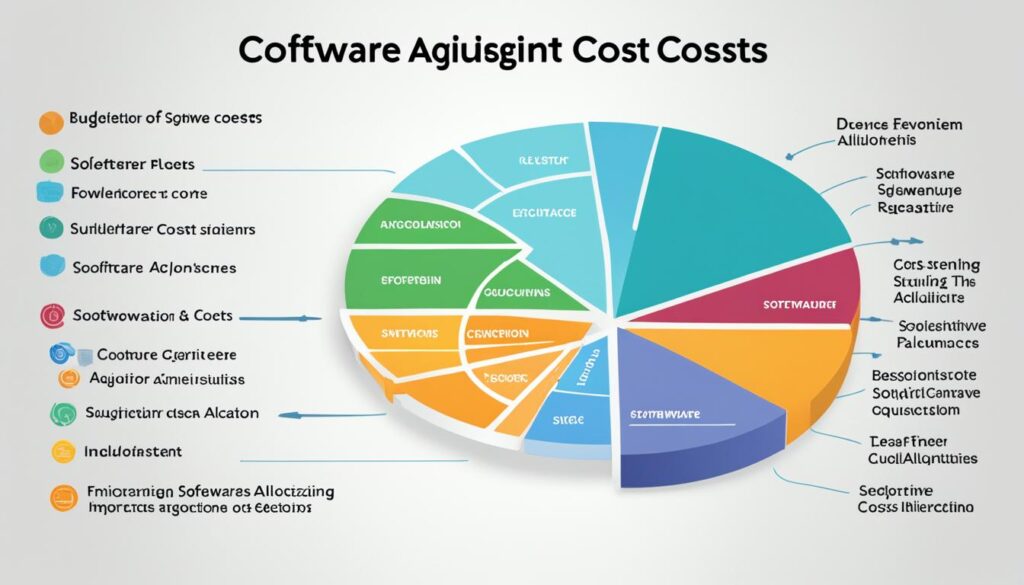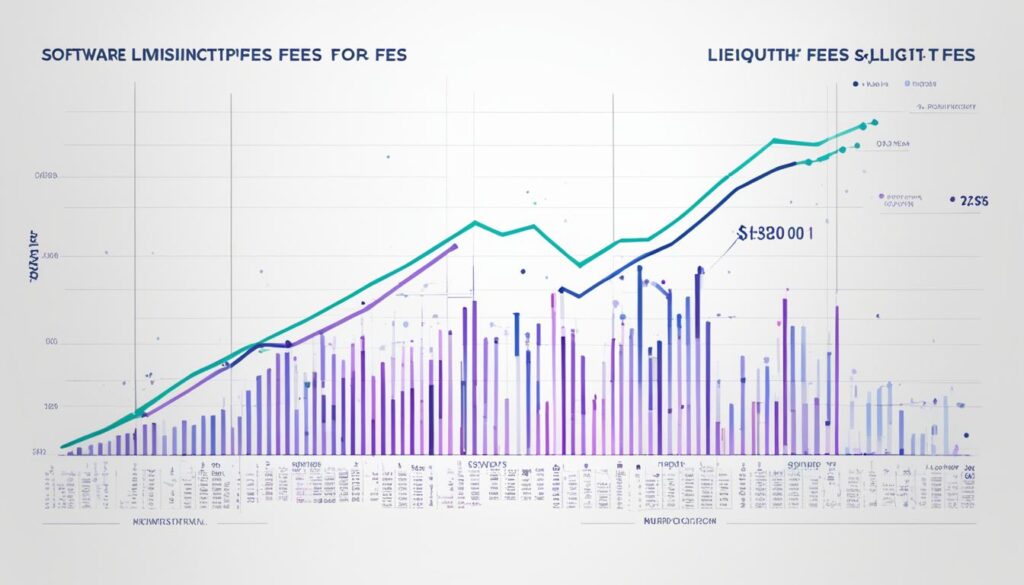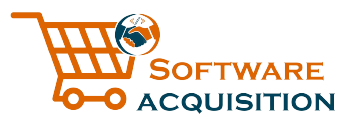Understanding the cost of buying software is key for any organization looking to grow. It’s not just about the price tag on the software. It includes all the money spent on sales and marketing to get that software. Knowing the full price is critical, as software prices are going up in the tech world.
The cost of owning software over time is also crucial for companies. It helps decide if the software will be worth it in the long run. This decision impacts a company’s financial future and its ability to make money.
Key Takeaways
- Understanding software acquisition costs is crucial for sound financial decision-making.
- Assessing total cost of ownership helps forecast long-term software investment viability.
- Direct expenses and indirect resources must be factored into software purchase expenses.
- Software procurement cost involves strategic and operational considerations.
- Effective cost analysis informs sustainable growth and profitability strategies.
- Maintaining a grip on software expenses is key in a rapidly evolving tech market.
Demystifying Software Acquisition Cost
Understanding the cost of buying software is key to making good budget plans. It helps you spend wisely on software acquisition strategies and software budget allocation. Knowing these costs helps businesses cut software deployment expenses without losing quality.
Defining the Components of Software Acquisition
The cost of software includes many factors, not just the purchase price. It covers things like licensing fees. These make up just part of the total cost.
Impact on Overall Company Finances
Understanding all costs is about more than just buying the software. It includes maintenance and other needs over time. This is crucial for keeping your company’s finances healthy and planning your budget better.
Software Acquisition vs Software Procurement: A Comparative Analysis
When we look at software acquisition and software procurement, we see big differences. Though both are important, they serve different needs and steps in the software’s life.
| Acquisition Strategy | Procurement Process |
|---|---|
| Targeting software sourcing | Transactional purchasing |
| Long-term strategic planning | Short-term operational focus |
| Emphasis on integration with business goals | Focus on cost and efficiency |
| May include custom development | Generally involves off-the-shelf solutions |
Software Acquisition Strategies for Optimal Budgeting
When dealing with software acquisition cost, businesses face a tough challenge. They must plan their budgets to get the most value. Seeking strategies that fit their needs, they work to cut down on software purchase expenses. Achieving a balance between quality and affordability boosts their financial health in the long run.

Evaluating marketing channels and product offers is crucial. Companies need to see which channels best reach their audience. They also weigh the special features of their software against the competition. Considering both price and quality is vital for success.
Looking at software budgeting needs checking many areas:
- Marketing Channel Efficiency: How effectively do these channels attract and convert prospects?
- Target Audience Demographics: Do marketing strategies align with the audience’s needs and interests?
- Industry Competition: How to stand out from rivals and attract more customers?
- Product Quality: Are the product’s features good enough to warrant its price?
- Geographic Considerations: Do location factors affect the software’s adoption and success?
Smart software budget allocation goes beyond just cutting costs. It’s about investing in prospects likely to bring in more revenue over time. By focusing on these high-quality leads, companies can better handle initial software acquisition costs. This sets them up for sustainable profit.
Getting the right software acquisition strategy requires continuous effort. As trends and technology evolve, being adaptable and agile is key. This way, companies not only cope but also excel in the competitive software market.
Software Licensing Fees and their Influence on Acquisition Cost
When evaluating software costs, the focus is often on the upfront investment. Yet, smart businesses look deeper. They know that true expenses are hidden in software licensing fees. These fees can be big. So, grasping their structure is key to understanding the total software ownership cost.
Different licensing models have different terms. These can lead to savings or extra costs for your organization.

Understanding Different Licensing Models
Licensing models vary, from one-time buys to subscriptions. Each affects your company’s finances differently.
One-time licenses might cost more at first but often mean lower costs over time. However, subscriptions have smaller initial fees but may cost more as time goes on. Your choice in licensing model will directly alter your software buying costs.
Negotiating Software Licenses to Your Advantage
Negotiating licensing fees is a strategic move. Matching licenses to your actual software use can help. This alignment ensures your software spending reflects the value received. It might mean talking terms for volume licenses, lengths, or even usage caps.
This way, you can keep your software buying costs in check.
Renewal Costs and Long-term Financial Implications
It’s vital to watch renewal fees, too. After buying, licensing fees can change, and renewal terms can deeply affect your long-term software costs. To avoid high expenses later, negotiate renewal terms early. This sets up favorable conditions that control future costs.
| Licensing Model | Pros | Cons | Impact on TCO |
|---|---|---|---|
| Perpetual License | One-time payment, full ownership | Higher initial cost, potential obsolescence | Lower over time if the software is used long-term |
| Subscription Model | Lower initial investment, regular updates | Ongoing payments, potentially higher overall cost | Higher over time due to recurring fees |
| Usage-Based License | Pay for what you use, scalable | Unpredictable costs with fluctuating usage | Varies with the level of use; may be cost-effective or expensive |
Analyzing Total Cost of Ownership in Software Investment
When companies buy software, knowing the total cost of ownership software is key. It’s more than just the price paid at the beginning. The total cost includes software deployment expenses, and money spent on maintenance, upgrades, and support later on.
Analyzing these costs is vital. It helps predict long-term spending. It also shows how the software affects the company’s money. We must look at obvious costs like upgrades. Yet, hidden costs like training staff are just as crucial.
To show how costs add up, here’s a breakdown. It shows both direct and indirect expenses. Such a breakdown is common for most organizations:
| Type of Expense | Direct Costs | Indirect Costs |
|---|---|---|
| Initial Purchase | Licensing fees | Assessment and decision-making labor |
| Deployment | Implementation and configuration services | Employee training sessions |
| Maintenance | Annual support contracts | Additional staff required for ongoing support |
| Upgrades | Upgrade service fees | System downtime |
| Operational Impact | Increased energy consumption | Productivity loss during system outages |
It’s vital for businesses to recognize and plan for these costs. This way, they’re ready financially. They can also see the real benefit of their investment. Software isn’t just a purchase; it’s an investment in the company’s future success. So, calculating the total cost of ownership software precisely is essential. It guides strategic decisions and resource use.
Calculating Software Acquisition Cost Accurately
To understand software acquisition cost well, it’s key to look closely at each factor that adds to this total metric. By getting into the details, smarter choices can be made when buying new software. This prevents missing important cost factors that could mess up a company’s budget.
Essential Metrics in Calculating Software Acquisition Cost
Analyzing different metrics is crucial for insights into the software buying process. These metrics help fully grasp the costs of getting software. Considering sales, marketing, labor, and overhead is vital to see all expenses. This way, leaders know how to best use money for software purchases.
Common Pitfalls in Miscalculating Software Costs
Messing up the estimated costs of software implementation can cause big problems. Companies often forget to include all expense types in their calculations. Missing costs like ongoing customer support, new client onboarding costs, and big integration complexities are common errors. Avoiding these mistakes is key to keeping a solid budget during software buying.
Role of Historical Data in Estimating Future Costs
For forecasting future costs, past data is very valuable. It offers lessons that help predict software buying and procurement expenses. This past data shows how similar projects went finance-wise in the past. This helps in making better future spending plans for new software projects. Companies that keep track of such data make smarter budgeting choices.
| Cost Element | Consideration in Acquisition Cost | Impact on Procurement Cost | Implications for Implementation Costs |
|---|---|---|---|
| Software Licensing Fees | Upfront purchase or subscription models | Direct initial procurement expense | Recurring costs impacting long-term budget |
| Marketing & Sales Expenditure | Lead acquisition, promotions, and outreach | Operational costs influencing procurement process | Sales team training and software tools integration |
| Labor & Overhead | Personnel salaries, office space, equipment | Administrative costs affecting bottom-line procurement | Onboarding and ongoing technical support |
How Software Implementation Costs Factor into the Equation
When companies think about buying new software, they look at the price and licensing fees. But, it’s critical not to forget software implementation costs. These costs include the installation, making the software fit company needs, and training employees. Together, these can add up and greatly affect the total cost of owning the software.
Setting up new software can be complex, especially for businesses with unique needs. Making the software work with existing systems can be pricey. Besides money, implementing software also takes time and resources. This can impact how the business runs for a while. It’s vital to plan for these costs to truly understand what you’re spending.
After buying software, teaching employees how to use it is key. It’s important to make sure your team can use the new tools well. If not, you might end up spending more than you thought and mess up your business flow. So, leaders should carefully consider all expenses related to new software. Doing this helps align financial planning with the software setup plan. This way, businesses can smoothly incorporate new systems and get the most from their investment.




